The Intel 6th Gen Skylake Review: Core i7-6700K and i5-6600K Tested
by Ian Cutress on August 5, 2015 8:00 AM ESTWhat You Can Buy: Linux Performance
Built around several freely available benchmarks for Linux, Linux-Bench is a project spearheaded by Patrick at ServeTheHome to streamline about a dozen of these tests in a single neat package run via a set of three commands using an Ubuntu 11.04 LiveCD. These tests include fluid dynamics used by NASA, ray-tracing, OpenSSL, molecular modeling, and a scalable data structure server for web deployments. We run Linux-Bench and have chosen to report a select few of the tests that rely on CPU and DRAM speed.
C-Ray: link
C-Ray is a simple ray-tracing program that focuses almost exclusively on processor performance rather than DRAM access. The test in Linux-Bench renders a heavy complex scene offering a large scalable scenario.
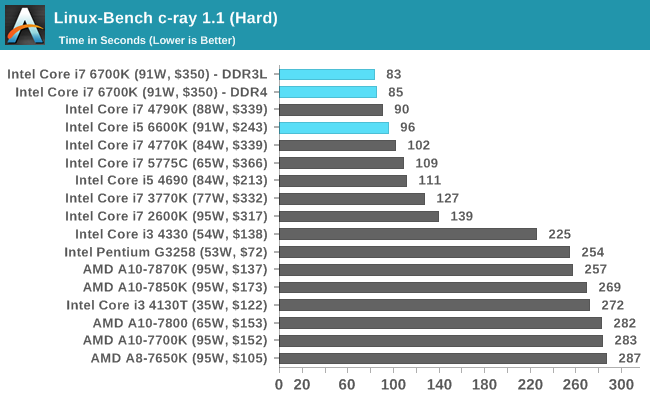
NAMD, Scalable Molecular Dynamics: link
Developed by the Theoretical and Computational Biophysics Group at the University of Illinois at Urbana-Champaign, NAMD is a set of parallel molecular dynamics codes for extreme parallelization up to and beyond 200,000 cores. The reference paper detailing NAMD has over 4000 citations, and our testing runs a small simulation where the calculation steps per unit time is the output vector.
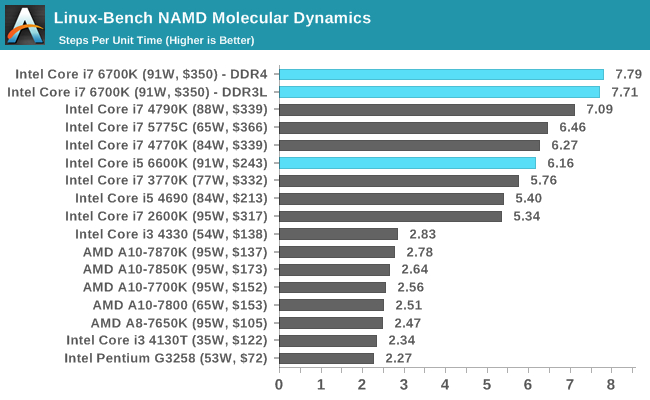
NPB, Fluid Dynamics: link
Aside from LINPACK, there are many other ways to benchmark supercomputers in terms of how effective they are for various types of mathematical processes. The NAS Parallel Benchmarks (NPB) are a set of small programs originally designed for NASA to test their supercomputers in terms of fluid dynamics simulations, useful for airflow reactions and design.
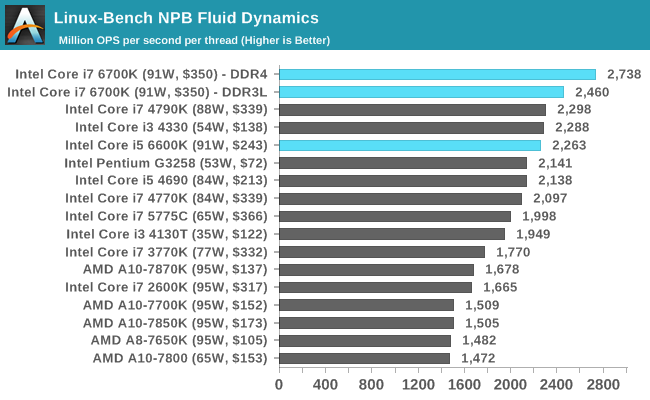
Redis: link
Many of the online applications rely on key-value caches and data structure servers to operate. Redis is an open-source, scalable web technology with a b developer base, but also relies heavily on memory bandwidth as well as CPU performance.
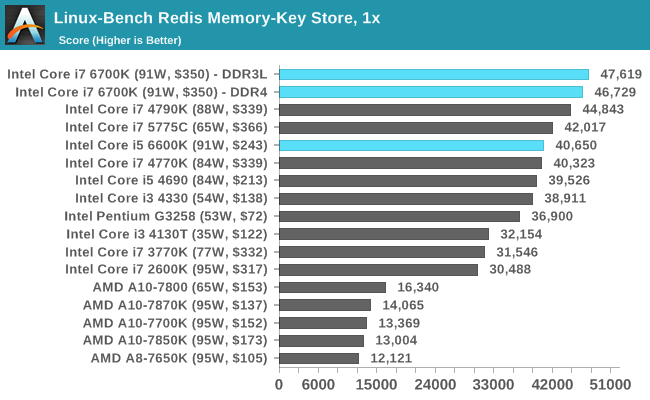
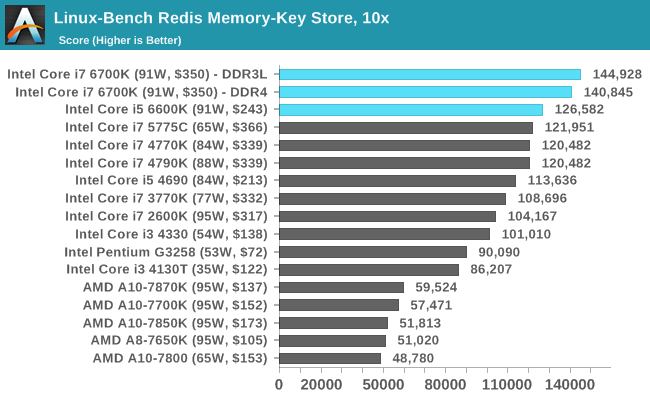
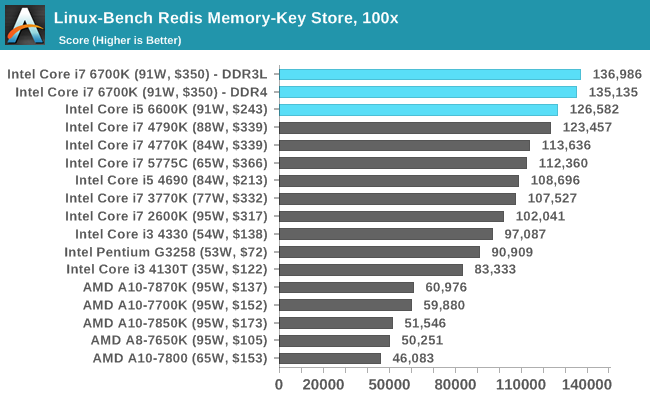










477 Comments
View All Comments
experttech - Monday, August 10, 2015 - link
I have a Sandy Bridge 2600K running on a Asus H67 EVO motherboard, so not overclocked. My motherboard is slowly dying. First the obboard sound died, then the reset is now working. Now I am wondering whether to upgrade the motherboard to an overclockable Sandy Bridge motherboard or jump the wagon to 6700K. I mostly do Video Editing and Encoding, no gaming. or wait till the motherboard dies completely and hope SkyLake E or Kaby Lake is out by that time. Any suggestions?sonny73n - Wednesday, August 12, 2015 - link
2600K is an excellent chip. I'd rather have the i7-2600K than the new i5-6600K. You should get a new MB Z77 but there's not many still available now. I only saw 1 Z77 on Newegg, it's the Asrock and I think it costs around $160. You can also find used Z68 and Z77 MBs on Amazon or eBay but I wouldn't recommend it. Video editing with the 2600K is a piece of cake and x264 encoding is not bad either. Keep the chip and spend your money on a good video card and a nice 4K ips monitor.experttech - Thursday, August 13, 2015 - link
Thanks for your reply. I too realized the same, I did notice the only Z77 Asrock motherboard (which is an excellent motherboard by the way) but for the price, I can't justify buying it especially since so many options are available in the new platform. One interesting thing I noticed is that with the newer instruction sets, my laptop with i5 5200U actually renders some frames very fast but overall, my i7 2600K renders the finished movie quicker. So though there are IPC improvements in the newer chips, the basic features (performance, mutithreading etc) haven't changed night and day. Of course I am comparing a Sandy bridge i7 to a lower clocked Broadwell i5 but I am not sure if there will be a tangible difference upgrading to SkyLake as of now. So you are right my friend and thanks for the advice!I do have a 1440p monitor and its amazing how much real estate you get going from 1080p. Definitely one of the best upgrades I made. I will look into a 4K monitor as they have come down quite a bit in price.
phillipstuerzl - Monday, August 10, 2015 - link
Hi,On your 5th page, under Test Setup, you list the i5 6600K as being 4C/8T. This is incorrect. It is not hyperthreaded, and only 4C/4T.
Great article!
Ryan Smith - Tuesday, August 11, 2015 - link
Thanks!DannyDan - Monday, August 10, 2015 - link
So do we expect the 1151 socket to have a few good upgraded processors down the road? It really sucked getting a socket 1156 CPU.mdw9604 - Tuesday, August 11, 2015 - link
Moore's law is a crock of $%!24. 7 years later and Intel still hasn't doubled the performance the i7 870. Core for Core.The may be able to cram more transistors into a smaller space, but doesn't mean better performance.
Oxford Guy - Thursday, August 13, 2015 - link
It's funny how every time it fails people say it is being "adjusted", "extended", "massaged", "modified", or something like that. Either it works or it doesn't. It should be called Moore's Heuristic = "process density increases over time" (duh).ES_Revenge - Saturday, August 15, 2015 - link
You misunderstand Moore's Law. Moore's law has nothing [necessarily] to do with performance. Moore's law only states that the number of transistors possible in a given space will double every two years. It also doesn't just apply to Intel and mainstream CPUs, it applies to *all* integrated circuits. Everything from CPUs to EEPROMS, to SOCs, to microcontrollers, to image sensors...etc. these things are all included as they're all ICs. So, on average, it still holds AFAIK.Whether or not a 14nm chip outperforms, or how much it outperforms, a 28nm one (there wasn't one for Intel, but Sandy was 32nm) is NOT what Moore's Law predicts. Other people have construed this "Law" to mean things about performance (including some guy at Intel that once said performance would double every xx months--totally wrong and not what Moore's Law states anyway), but it's not about performance and certainly not just about desktop CPUs.
You can't say something is a "crock of $%!24" if you don't know what it's about to begin with.
Kutark - Thursday, August 20, 2015 - link
Unfortunately, whether or not someone understands something has never stopped someone from speaking their mind on it. Hell, look at pretty much every election under the sun. The vast majority of people who vote in them couldn't even give you a basic rundown of the issues at hand, yet they sure do have an opinion on it...